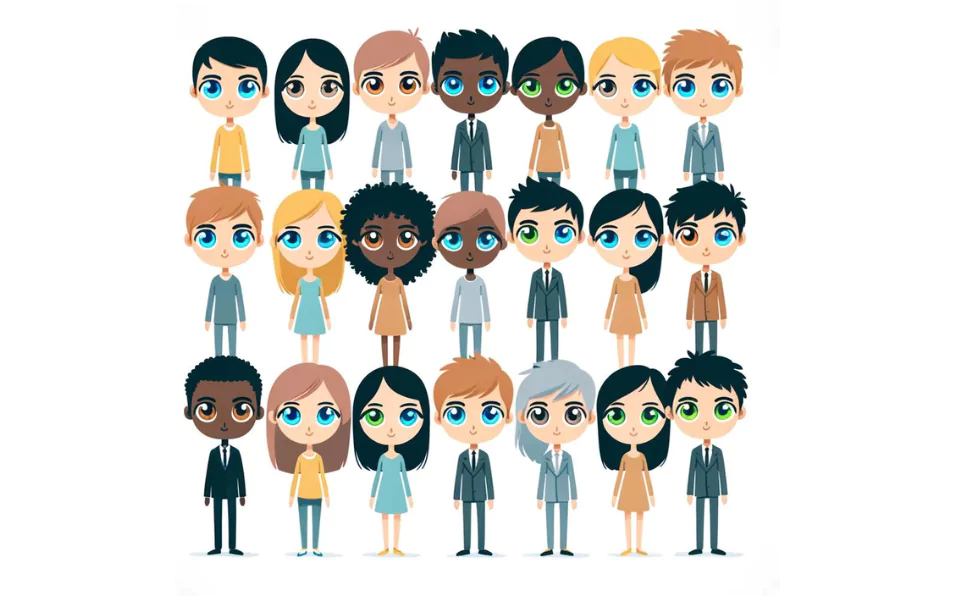Have you ever gazed into a pair of blue eyes and wondered about the chances of blue eyes in your family? Or been curious about what makes your neighbor’s eyes green and yours brown?
The answers to these intriguing questions lie in the field of color eyes genetics, a captivating area that explores how eye color genes play a vital role in determining eye color.
From dominant eye color patterns to the probability of eye color in offspring, the genetics of eye color is a complex and fascinating subject.
In this article, we will unravel the mysteries of eye color dominance, explore genes for eye color, and discover the factors that make human eyes so wonderfully diverse.
Whether you’re curious about the determining factors of eye color or want to understand the chances of a particular eye color in your family, this exploration of eyes color genetics will provide you with insights into the world that lies behind those expressive windows to the soul.
Quick Note:
If you’re looking for a quick answer, Eye color is largely determined by genetics, particularly by genes that control the amount and type of melanin in the iris.
The complexity of eye color genetics involves several genes, with the OCA2 and HERC2 genes playing significant roles. While brown is generally considered the most common and dominant eye color, the interplay of various genes can produce a spectrum of colors, including blue, green, hazel, and gray.
The probability of a child’s eye color is influenced by the eye colors of their parents, but it’s not a straightforward calculation due to the polygenic nature of eye color inheritance.
For an in-depth exploration of the fascinating world of eye color genetics, including how different genes contribute to the range of eye colors and the intricacies of inheritance patterns, keep reading our comprehensive article.
Understanding the Color of Eyes
Eye color is an interesting characteristic influenced by various factors like genetics, pigments, and light.
Your eye color is primarily determined by the iris, the colored part of your eye.
It consists of two layers: the stroma, a front layer containing fibers, blood vessels, and cells, and the pigment epithelium, the back layer filled with melanin (a brown pigment) affecting your skin and hair color.
Melanin is the key player in eye color.
More melanin makes darker eye color, while less leads to lighter shades.
It also impacts how light interacts with your iris, resulting in different shades and patterns of color.
The Spectrum of Colors in Eyes
The world showcases an array of eye colors, from pale blue to deep brown, influenced by melanin. Here’s how it works:
- Brown eyes: The most common eye color, with 70-80% of the global population having brown eyes. High melanin content gives the deep brown shade. The eye color chances of brown vary from light amber to almost black.
- Blue eyes: 8-10% of people globally have blue eyes, characterized by low melanin, allowing more light to reflect, giving the blue appearance. The probability of eye color being blue depends on collagen levels in the stroma.
- Green eyes: A rarity, with only 2% having green eyes. Moderate melanin creates a balance between absorbing and reflecting light, and pheomelanin adds a golden or hazel tint.
- Hazel eyes: A blend of green and brown, found in 5% of the population. The amount of melanin varies, creating rings of color around the pupil. Hazel eyes can change color with different lighting or mood.
- Gray eyes: Uncommon, with only 3% having gray eyes. Low melanin makes them appear nearly transparent, and they can reflect various colors.
- Amber eyes: Rare, seen in 5% of people, with high pheomelanin giving a yellowish or golden hue, and eumelanin adding depth or intensity.
Unusual eye colors like violet, red, or heterochromia exist, caused by genetic mutations, medical conditions, injuries, or contact lenses.

Eye color is a stunning and diverse feature that mirrors your ancestry, personality, and well-being.
Genetics of Eye Color
Have you ever wondered what determines your eye color? is it just a roll of the dice, or is there a scientific explanation?
Let’s explore the color eyes genetics, uncovering how genes for eye color interact and affect the hue of your eyes.
Eye color genetics is more complicated than simply inheriting it from your parents.
Many genes are at play, affecting melanin production, transport, and storage in the iris. These eye color genes are categorized as dominant, recessive, or co-dominant, influencing the inheritance and expression of eye color.
Dominant eye color genes override others, recessive ones show up only if two copies are inherited, and co-dominant genes blend together to create new colors.
Many genes for eye color regulate melanin production and distribution, determining eye color based on the combination of alleles (gene versions) inherited from your parents.
The Main Eye Color Genes
As we know eye color is determined by melanin, a pigment found in the iris, the colorful part of your eye. Melanin’s production and storage is controlled by cells known as melanocytes, which are guided by genes.
Genes are like a recipe that helps your body perform different functions by making the required proteins.
Two main genes, OCA2 and HERC2, play a vital role in eye color dominance. These are part of your chromosomes, the structures that hold your DNA.
Each person has two versions of these genes (called alleles), inherited from both parents. These genes control a protein (P protein) involved in making melanin. More P protein means more melanin, leading to darker eyes, and vice versa.
The alleles that affect your eye color chances can be split into two categories: contributing (making more melanin) and non-contributing (making less melanin). Your dominant eye color is determined by the mix of these alleles.
For instance, two contributing alleles from OCA2 will likely give you dark brown eyes. Two non-contributing alleles might result in light blue eyes.
HERC2 on the other hand control the expression of the OCA2 and atleast one allele of HERC2 is reported to reduce the expression of OCA2 and in that case the individual can have blue eyes even in the presence of contributing OCA2 alleles.
However, these genes don’t work alone. They interact with other genes, creating a diverse range of eye colors in different people.
The Complexity of Inheritance
Determining eye color isn’t simple; it’s complex and influenced by many genes and other factors, a phenomenon known as polygenic inheritance.
In addition to OCA2 and HERC2, there are at least 16 other genes like TYR, MLPH, TYRP1, SLC24A5, MATP, MC1R, SLC45A2, IRF4, ASIP, TPCN2, SLC24A4, MYO5A, DCT, GPR143, MITF, and PMEL involved in this process. These genes affect various aspects of melanin in your iris, such as its type, amount, location, and pattern.
These genes don’t all work equally or simply add together. Some have more power than others, some change or hide others’ effects, and some interact in intricate ways.
One example is the MC1R gene. It affects the type of melanin made, with two main versions: R (red) and r (brown). These create different shades of red or brown melanin, and the interactions between them can be quite complex.
The way these genes are passed down isn’t random either. Some are linked and often inherited together, like OCA2 and HERC2.
Eye Color Inheritance Pattern
Predicting Eye Color
Determining eye color isn’t as simple as saying one “dominant eye color” will always win over another.
For example, we can’t just say brown eyes will always be dominant over blue eyes. Some parents with blue eyes can have a child with brown eyes, and there are other colors like green or hazel.
The truth is, eye color is something called a polygenic trait, meaning many genes work together with each other and the environment. This makes a range of eye colors, from light blue to dark brown.
Trying to predict eye color isn’t perfect, but we can guess the “probability of eye color” in a child based on the parents’ eye colors.
Child Eye Color Predictor
Select Eye Color of Mother, Father & Grandparents (if known)
Using this calculator, you can figure out the “chances of blue eyes” and other colors.
But these tools aren’t always right and can’t think of every way eye color can vary.
Parental Influence
The “color eyes genetics” are inherited from both mom and dad.
Each parent gives one part of each eye color gene to their child, and the child’s eye color comes from how these parts work together.

For example, if both parents have brown eyes but also have a part for blue eyes, there’s a 25% chance of a blue-eyed child, a 50% chance of brown with a blue part, and a 25% chance of just brown eyes. But this is a simple way to think, as eye color involves more than one gene.
Some wrong ideas about “what determines eye color” include thinking it comes from only one gene with brown (B) and blue (b) parts, or that it’s decided by the grandparents’ eye colors, or that it can change over time.
Eye color is a wonderful thing that shows our genetic variety and where we come from. Many genes working with each other and our surroundings make it happen.
Environmental and Other Factors
Eye color is not only shaped by genetics, but it’s also influenced by the environment and other aspects.
These elements can alter the amount and layout of melanin, the pigment responsible for the color in our eyes, skin, and hair. Here are some non-genetic factors that have a bearing on eye color:
- Sunlight exposure. Sunlight can prompt melanin production in the eyes, possibly making them look darker or more brown over time. This is particularly noticeable in individuals with lighter eye shades such as blue or green. Sunlight may also create freckles or spots on the iris, thereby causing temporary eye color changes.
- Diet and nutrition. Certain foods and nutrients may affect the melanin in the eyes, influencing the genetics of eye color. Foods high in antioxidants, such as berries, spinach, and carrots, may preserve the eyes from oxidative stress and prevent melanin loss. Foods containing copper, like nuts, seeds, and shellfish, may boost melanin creation and influence the dominant eye color, making eyes more brown.
- Hormonal changes. Hormones play a role in eye color dominance by impacting melanocytes, the cells that produce melanin. For example, during periods like pregnancy, puberty, adolescence, and menopause, eye color may shift due to fluctuations in estrogen and testosterone, determining eye color alterations.
- Medications and drugs. Some medicines and drugs can modify eye color by influencing the iris or the lens. Certain glaucoma medicines might enhance melanin in the iris, turning the eyes more brown or green. Some antibiotics and antihistamines can lessen iris pigmentation, making eyes appear bluer or grayer. Steroids and chemotherapy drugs may induce cataracts, which cloud the lens, impacting vision and eye color.
Diseases or conditions changing eye color
Several diseases or conditions can modify eye color by harming or affecting different eye components, including:
- Albinism. This genetic condition leads to a melanin deficiency in the body. People with albinism have pale skin, hair, and eyes. Their eyes might seem pink or red, showing the blood vessels through the iris. This condition represents a significant example of genes for eye color and accompanies vision issues like nystagmus, strabismus, photophobia, and low visual acuity.
- Ocular albinism. A type of albinism mainly impacting the eyes. Individuals with this condition have typical skin and hair but little or no eye pigment, with eyes appearing light blue or gray. Their vision problems are similar to those with albinism.
- Heterochromia iridis. This condition causes different colors in each eye or within a single eye, revealing the complex genetics of eye color. Heterochromia iridis may be hereditary or acquired, affecting the chances of blue eyes, for instance. It may be linked to other eye disorders like glaucoma or uveitis.
- Fuchs heterochromic iridocyclitis (FHI). FHI is a chronic inflammation type affecting the iris, causing one eye to change color gradually. The affected eye may become lighter or darker, and what determines eye color in this case might be an infection or autoimmune disorder. The condition can also lead to cataracts or glaucoma.
These aspects highlight how eye color is not solely based on genes for eye color but encompasses a range of influences, providing a comprehensive understanding of eye color genetics, dominance, and determining factors.
Aging and Eye Color
As people age, changes happen in their eyes that can affect their eye color. Let’s look at what these changes are:
- Loss of Color in Eyes: When you get older, your body produces less melanin, affecting the color of your skin, hair, and eyes. The iris might lose pigment and appear grayer or bluer than before, especially if you had dark eyes when you were younger. This is more noticeable in those with dominant eye color like brown.
- Arcus Senilis: This condition creates a white or gray ring around the cornea (clear front of the eye). It happens because of aging or high cholesterol and doesn’t affect vision. But it might seem like your eye color has changed.
- Cataracts and Eye Color: Cataracts cause clouding in the eye’s lens, making them look dull or yellow. This can mess with vision and eye color, but surgery can fix it.
Genetic Conditions That Affect the Eyes
Your eye color is mostly determined by genetics, meaning it’s inherited from your parents. But some conditions can change eye color:
- Oculocutaneous Albinism (OCA): A genetic disorder causing a lack of melanin, the stuff that gives color to skin, hair, and eyes. People with OCA have very light colors and vision problems.
- Waardenburg Syndrome (WS): This affects the melanocytes, cells that create melanin, and can change eye appearance. It’s an example of how genes for eye color can be altered.
- Neurofibromatosis Type 1 (NF1): A disorder causing tumors in nerve cells, which might affect the eyes in different ways, showing the role genetics play in determining eye color.
- Aniridia: People with this genetic condition have a partial or complete lack of the iris, which can cause various vision problems and is linked to the genetics of eye color.
Specific Disorders and Eye Appearance
Some particular disorders can change the appearance of the eyes:
- Bietti’s Crystalline Dystrophy (BCD): This rare disorder affects the retina and cornea, causing crystals to form, impairing vision, and changing eye color, relating to the genetics of eye color.
- Blepharospasm: This causes spasms of the eyelid muscles, making it hard to open or close the eyes and changing eye appearance.
- Coloboma: A birth defect that affects eye development, creating gaps in structures like the iris, retina, or lens. It can cause unique appearances like keyholes or cat eyes.
- Graves’ Eye Disease (GED): Linked to thyroid issues, GED can cause changes in eye appearance, such as bulging eyes, affecting the chances of blue eyes or other eye color changes.
In summary, various factors can have a strong impact on eye color. The probability of eye color changes is influenced by factors such as aging, genetic disorders, and specific conditions affecting the eyes (These changes can be temporary or permanent in some cases).
Eye Color and Human Population
The color of a person’s eyes, or eye color, is one of the most eye-catching parts of their appearance. Eye colors can range from dark brown to light blue, green, hazel, or even red.
But are there differences across different groups of people?
As we discussed, eye color is something that you inherit from your parents, and it depends on multiple genes, also known as the eye color genes.
According to the American Academy of Ophthalmology (AAO), brown eyes are the most common, with over 50% of people in the world having them.
However, eyes color genetics varies by where people live and their ethnic background.

For example, blue eyes, or what you could call the chances of blue eyes, are common in Europe, reaching up to 80% in some places.
Green eyes are rare, only about 2% globally, and hazel eyes are found in about 5% of people worldwide.
Scientists have many ideas about how these dominant eye color differences came to be. One idea is that eye color changes happened as humans moved from one part of the world to another, adapting to different conditions.
Blue eyes might have come from a single person with a genetic change reducing melanin in their eyes around 10,000 years ago.
Final Words on Genetics of Eye Color
Eye color is an exciting part of human genetics. The genes for eye color interact with each other and the environment to create all the eye colors we see.
Eye color dominance and the determining eye color process vary a lot, depending on where people live and their background. These different eye colors might have evolved due to natural selection or other reasons.
By understanding about eye color chances and what determines eye color, we can learn more about who we are.
Hopefully, this article has made you more interested in the color eyes genetics, and the overall subject of genetics and eye color.
Frequently Asked Questions (FAQs)
What determines eye color in a child?
The genetics of eye color is complex, with multiple genes such as OCA2 and HERC2 playing a vital role in determining eye color. These genes have different versions called alleles, inherited from both parents. Eye color dominance, specifically the dominant brown eye color, impacts the resulting eye color, as brown is dominant over blue. Different combinations of alleles inherited from both parents can lead to various shades, making eye color inheritance multifaceted and often unpredictable.
Which eye color is considered dominant?
Brown eye color is generally regarded as the dominant eye color, meaning that a person with brown eyes has a higher probability of passing this trait to their children. However, determining eye color is more complex, involving factors like pigment amount, light scattering, and the interaction of multiple genes.
What is the rarest eye color?
The rarest genetic eye color, possibly violet or red, can occur naturally. Violet eyes are due to a lack of pigment in the iris, reflecting more blue light. Often seen in albinism, a condition affecting melanin production, red eyes occur when there’s no pigment, making the blood vessels visible. Both violet and red eyes are incredibly rare, possibly indicating a health concern needing medical attention.
Can two blue-eyed parents have a brown-eyed child?
Though unlikely, two blue-eyed parents can have a brown-eyed child. The chances of blue eyes are typically linked to the variations in OCA2 and HERC2 gene. To have a brown-eyed child, If the blue eye color of the parents is primarily due to the HERC2 variation that inhibits OCA2, and not because of a lack of melanin-producing capability inherent to OCA2 itself, then it’s possible for them to pass on alleles that allow for full OCA2 function to their child. If the child does not inherit the HERC2 variation that reduces OCA2 activity, the child could express the melanin production levels for brown eyes, assuming there are no other inhibitory factors. Though rare, this scenario is not impossible.
What’s the most attractive eye color?
Beauty is subjective, and the “prettiest” eye color varies by individual and cultural preference. Some surveys, like a 2023 poll by All About Vision, have attempted to measure attractiveness, finding green eyes most appealing to their participants. Opinions may vary widely, reflecting diverse tastes and cultural influences.
Is black eye color rare?
Black eyes, which are very dark brown eyes rich in melanin, are not truly a separate color but are rare compared to other brown shades. More common in people with darker skin tones, these eyes reflect a higher melanin concentration needed for sun protection.
Are dark brown eyes uncommon?
Dark brown eyes are not rare globally but may be less common in specific regions or ethnicities. With 55% to 79% of people worldwide having brown eyes, the distribution varies by geography and ancestry. For instance, brown eyes are prevalent in Asia, Africa, and South America, but lighter shades may be typical in other regions.
Do violet eyes and lavender eyes exist?
Yes, both violet and lavender eyes exist, though they are rare. Violet eyes, often seen in albinism, result from a lack of pigment, reflecting blue light. Lavender eyes, a variant of violet with a pinkish hue, were famously associated with actress Elizabeth Taylor, though some debate her true eye color.
Do rainbow and pink eyes exist?
Rainbow eyes are artificial, created by special contact lenses for aesthetic purposes. Pink eyes are not a natural color but a sign of conjunctivitis, an eye infection or inflammation.
Are yellow eyes real?
Yellow eyes, not a natural eye color, indicate a medical condition called jaundice, caused by excess bilirubin in the blood. This symptom should be evaluated by a healthcare provider.
Can eye colors change from brown to blue?
Eye colors can change from brown to blue due to ocular albinism type 1 (OA1), a rare genetic condition affecting melanin in the eye. It’s specific to this condition, involving a mutation in the GPR143 gene, leading to reduced pigment in the irises and retinas, making eyes appear blue instead of brown. This change doesn’t typically occur in the general population and is linked to vision issues like nystagmus, photophobia, and strabismus.
References:
- Human genetics | Description, Chromosomes, & Inheritance.
- Genetic Inheritance | Basic Biology.
- Genetic inheritance – Genetic inheritance – AQA – GCSE Biology – BBC.
- Eye color | Description, Heredity, & Variations | Britannica.
- Is eye color determined by genetics? – MedlinePlus.
- Study addresses causes of eye color variation in primates – Phys.org.
- Eye Colors: Rarest Eye Color, Baby Eye Color, Heterochromia.
- What determines eye color? – Medical News Today.
- The World’s Population By Eye Color – WorldAtlas.
- Most Common Eye Color – All About Vision.
- Eye Color Percentage by Country 2023 – World Population Review.
- Polygenic Inheritance – Definition and Examples – Biology Dictionary.
- Why Do Eyes Change Color? – East West Eye Institute.
- Evolution of Eye Color in Humans – ThoughtCo.

Dr. Sumeet is a seasoned geneticist turned wellness educator and successful financial blogger. GenesWellness.com, leverages his rich academic background and passion for sharing knowledge online to demystify the role of genetics in wellness. His work is globally published and he is quoted on top health platforms like Medical News Today, Healthline, MDLinx, Verywell Mind, NCOA, and more. Using his unique mix of genetics expertise and digital fluency, Dr. Sumeet inspires readers toward healthier, more informed lifestyles.





